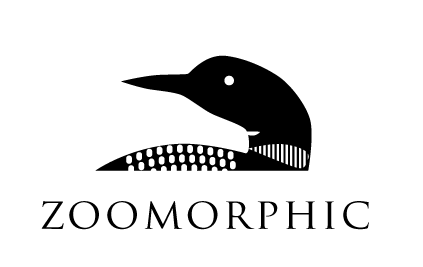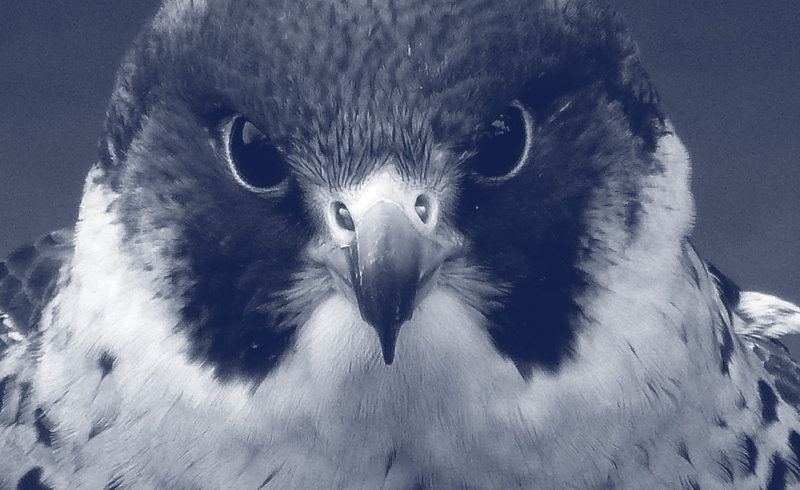by Miranda Cichy
I remember precisely what drew to me to J. A. Baker’s The Peregrine (1967), in an undergraduate lecture over a decade ago. The lecturer was Robert Macfarlane, who I would discover was one of the book’s great champions: largely responsible for bringing it to the attention of this century’s readers. Macfarlane told the story of a man in the east of England, John Alec Baker, obsessed with a dying species of bird, the peregrine, which looked nothing like the red-tailed hawk on the cover of the 2005 New York edition. When Baker was writing, the British peregrine population was in severe decline. Having halved in just 23 years – between 1939 and 1962 – it did not look set to recover in his lifetime. Macfarlane told us how Baker observed and recorded what he saw as the peregrines’ final days. How he pursued them through the winter months with a fixation beyond the meticulousness of the bird-watcher: something closer to desire, to longing, to love. How he wrote in his book about wanting to become the bird.
And then, how he did. J. A. Baker, Macfarlane told us, had arthritis – the exact type of which I would not learn for several years. But I can remember writing down what I had heard in the lecture that day with a small shiver of fascination: Baker’s arthritis became so bad that his knuckles knotted and fused together, and his fingers became like talons.
Three years later I was working in the publishing house that owned the rights to Baker’s work. On an endlessly rolling six-month contract in the rights department, I was far from my dream of sitting amongst the editorial team reading fresh manuscripts. I spent the tube journeys from east to west London writing, and my lunchtimes wandering along the large grey expanse of the Thames, buoyed by its resolute and continuous journey through the city. Aside from the cheap lunches and free stationery, my favourite thing about my job was the book store. Employees could purchase old paperbacks for 20p, hardbacks for 50p. I was using it to build up a collection of cookbooks, but every now and then something in fiction or non-fiction caught my eye.
It was in that bookshop one day that I saw a hardback copy of The Peregrine. I remembered the lecture, and the man whose hands grew into claws, and the focus on literature I’d had back then. I bought it.
It was summer; I read The Peregrine by the river. The book surprised me. I found within it lyrical descriptions of a watery, estuarine landscape, detailed observations of birds I didn’t know (I read “plover” to rhyme with “clover”). I waited for the section where Baker spoke of himself, of his arthritis. As the book went on, it became colder, more brutal: there were herons petrified in ice, the blood of pigeons blooming against the snow. The author’s affinity with the peregrines intensified: there was a passage where he “sank into the skin and blood and bones of the hawk” (145). But there was no reference to his health, or his fingers, or to talons.
When I finished The Peregrine I wondered if I had missed something. I wasn’t disappointed – its sentences hung round me like threads, some of which I have never shaken off – but my knowledge of Baker from that university lecture felt at odds with what I had read. I wanted to know more of the author, largely absent from the book: his home glimpsed once “through the frosted window-pane at sunrise” (132), his life in the simple dedication: “To my wife.”
Several years later, studying an MA in Literature and the Environment at the University of Essex, I was amazed to learn of the Baker archive. In the Albert Sloman Library, Baker’s life was packed tightly into two clear plastic boxes. I found his Miranda binoculars (it seemed like fate), his scrapbook of cut-out bird images, his early poems, his letters. And then, notes from an interview by the filmmaker David Cobham with Baker’s widow, Doreen, where I first learned the name of his illness: ankylosing spondylitis.
“Pictures are waxworks beside the passionate mobility of the living bird” (19), wrote Baker in The Peregrine. Words can be too. Ankylosing spondylitis. I learned the phrase with the same blankness with which I’d first read plover. I used it in my first MA essay, which I wrote on The Peregrine: on Baker’s obsession with birds, his literary aims. When I mentioned the passage where Baker “crawl[s] across stubble and dry plough”, I wrote that “such images are both less and more heroic when you imagine the author as he was: large, myopic, and arthritic.”
There are sentences you wish you could unwrite. Three months ago, a year after I had graduated from my MA, I heard the words “ankylosing spondylitis” again. This time they were from a doctor of medicine, not literature, as he listened to my symptoms of joint pain, discussed previous doctor visits, x-ray results, booked blood tests that would ultimately show the inflammation in my system. He was ruling out that particular rheumatological condition, he explained, because the worst of the pain was in my knees and ankles, rather than spine, and I nodded; I knew. The pain was so bad that I even looked up for ‘CBD oils UK‘ after a while because I wanted to try every possible thing that might have relieved my joint pain.
Well! I was fortunate to receive all of the assistance and find out everything on my own; however, many people, particularly the elderly, do not have access to such services. Many have dementia and arthritis both and require special care. That is why, they are either cared for by their children or by the professionals in senior housing in Omaha or elsewhere, where they are typically given 24-hour supervision to keep them safe. As the disease progresses to its final stages, round-the-clock care becomes more necessary.
Anyway, I live now, as Baker did. I love the landscape here for its expanse; for the heaviness of the clouds hanging above the water; for the endless rise and fall of the estuary banks, like lungs; for the glittering mud. For the godwits, curlews, plover (of which I know, now, there are several types) and sometimes the peregrines, when I am lucky – although we are already so much luckier than Baker ever imagined.
I love the east also for its flatness: for giving me the opportunity to walk, on the days the pain is not at its worst. I spent August and September away from the estuary, a lot of it on the sofa. Having always lived an outdoor life, I watched with desperation as the outside become the backyard, or what I could see of it: the bindweed choking the brambles, the block of sunlight flooding the sweet-peas. Some days the world is shrunk to one floor level. Some days it shrinks to my laptop: to self-diagnosis, self-prognosis, self-pity.
In the first week of October I went to the estuary. In previous months I would have taken a bus to the University, and walked along the river to Wivenhoe, and then beyond. This time we went direct to Wivenhoe. The walk was punctuated by benches. The following day was difficult. I think of what I wrote of Baker. Never less heroic.
It is a small loss that I never read Baker without being aware of his arthritis. Perhaps if he had access to options like CBD oils that people have nowadays he could have had some relief from the pain. Still, increasingly fewer people will come to The Peregrine without this knowledge, and I am sure that the forthcoming biography from Little Toller, My House of Sky, will further expand on this aspect of the author’s life. Macfarlane has written repeatedly of it, going so far as to say that Baker’s arthritis was one of two details (the second being short sight) that “bear most forcefully on The Peregrine.” He goes on: “Suffering as he did from curtailed vision and a stiffened body, the peregrine stood as both his dream totem and his prosthesis – perfected in precisely the ways that Baker was lessened.” Lawrence Buell has similarly speculated whether Rachel Carson’s “rage at the suffering inflicted on others’ bodies, and on earth’s body” was related to her own suffering from cancer during the latter stages of writing Silent Spring.
A small loss. I think, too, that it is not what Baker would have wanted. His biography on the first edition of The Peregrine was brief and wry and included the sentence: “He has no telephone and rarely goes out socially”. Not that this is going to be a piece about the rights of the author, or the power of the critic or biographer. So much of The Peregrine’s strength lies in the anonymity of the watcher: how we respond to his pursuit of – and increasing empathy with – the bird, his recoiling at mankind. I wonder how this changes for the reader who thinks of Baker in Macfarlane’s poorly-chosen term: “lessened”.
There is one instance in The Peregrine where Baker mentions arthritis. It is January, and he watches a moorhen walk across a frozen brook “with hushed, arthritic tread; the gait of the dying, yet still pathetically funny to watch” (129). I read that sentence again and wonder which part of it Baker wanted us to crystallise: the pathetic; the funny; the dying. Or just a description of a moorhen, carefully stepping its way across the ice.
1. David Farrier, “J. A. Baker’s The Peregrine and its Readers”, Interdisciplinary Studies in Literature and Environment, v. 22, no. 4 (Autumn 2015), p. 743.
2. J. A. Baker, The Peregrine [1967] (New York: New York Review of Books, 2005), p. 145
3. Robert Macfarlane, “Violent Spring: the nature book that predicted the future”, The Guardian, 15 April 2017 https://www.theguardian.com/books/2017/apr/15/the-peregrine-by-ja-baker-nature-writing
4. Lawrence Buell, The Environmental Imagination: Thoreau, Nature Writing and the Formation of American Culture (Massachusetts: Harvard University Press, 1995), p. 292.
Miranda Cichy is a writer and ecopoet with a particular focus on extinct and endangered animals. Her poems have most recently been published in Curlew Calling (Numenius Press, 2017), Driftfish (Zoomorphic, 2016), and the Nature and Myth and Nature and Regeneration pamphlets from Corbel Stone Press (2017). She currently lives in Essex and can be found on Twitter: @mirazc.”

